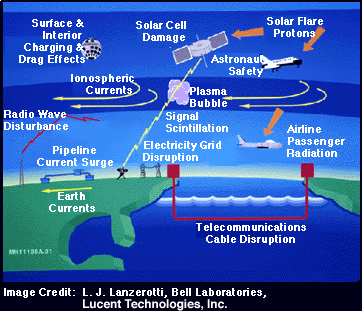Background:
The process of fusion liberates energy within the core of the sun. A small part of
this energy produces its magnetic field. Variations in the magnetic
fields (magnetic fluxes) result in solar events, some of which
include sunspots, coronal mass ejections (CMEs), and solar tornadoes.
This solar activity results in larger than average amounts of radiation
(from radio waves to gamma rays) and energetic particles
(such as high energy protons and electrons) ejected into space.
Just as moving air molecules on Earth constitute a wind, these
energetic particles make up the solar wind. This solar wind and solar activity are
measured by several spacecraft,
including the Advanced Composition Explorer (ACE). Some solar
events, when interacting with the Earth’s magnetosphere (magnetic field), can
create profound effects. These effects may include:
- Aurorae
- Lost satellites
- Geomagnetic Storms
- Disrupted Systems
- Communications
- Navigation
- Electric Power
- Radiation Hazards to Humans
- Increased pipeline corrosion
- Climate change
- Biological hazards and environmental disruptions
- Note to the learner: Ionospheric currents, plasma bubbles, and
signal scintillation are not discussed in this lesson, even though
they appear in the graphic below.

- For more in depth background, see Educational Brief on space weather
Also see
http://www.sel.noaa.gov/primer/primer.html.
For a more in depth slide show see
-
http://hpcc-k12.gsfc.nasa.gov/gessep/serverhome/gessep98/aceproject/inv1/slideshow1.html
- Other relevant internet links:
-
http://www.astro.lu.se/~henrik/spacew2.html
- http://www.nas.edu/ssb/spwpt5nw.html
- Procedure:
Investigation 1
1. After reading the procedure for this investigation, go to the following URL:
http://www.astro.lu.se/~henrik/spacew2.html
- 2. Print out and fill in this
flow chart after following the next step.
- 3. Examine the twelve images and captions. You may click on an image to find out more detailed information if you wish. Prepare to fill in the following flowchart.
4. Review recent solar events at:http://www.nas.edu/ssb/spwpt5nw.html
5. Describe past solar weather events that you have read thus
far, by listing and providing a 2 - 3 sentence long description
about the effects of these events on Earth:
-
-
-
-
-
-
- Coding:
Maryland Core Learning Goals (Science): 3.1.
National Standards (Science): Grades 5-8: A5, B3, D3, E2,F2, F3, F5
. Grades 9-12: B6, D1, E2,F5, F6,
National Standards (Geography): 7-2, 8-2.
National Standards (Mathematics): None
- Investigation Discussion and Questions
- Questions are included in the procedure above. For extensions,
see below.
Extensions:
Read the Education Brief on space weather
Create a fictional weather forecast as if you were a space weather forecaster. Make it for a time period in the future when an event is occurring. Remember that your function is to inform and teach people as well. You may choose to go further and actually do the forecast in front of your classmates - but remember that most forecasts are 3-5 min in length. Feel free to use graphics from the internet, the Ed. Brief, or this exercise. If you did this, I would be happy to hear about your experience with it.
- Other Investigations:
- Space Weather and You!
- Space Weather and You! Introduction 2
- Interpreting RealTime ACE Data From Space
- The Sun or The Supernova?
- ACE RTSW Data and Traditional Physics Problems
Credits:
Pat Keeney GESSEP Program
queen3@access.digex.net
Daniel Hortert GESSEP Program
howard6@access.digex.net
Dr. Eric R. Christian
ACE Deputy Project Scientist
cosmicopia@cosmicra.gsfc.nasa.gov
Dr. John Krizmanic
Astroparticle Physicist
cosmicopia@cosmicra.gsfc.nasa.gov
Beth Barbier
ACE Outreach Specialist
cosmicopia@cosmicra.gsfc.nasa.gov

